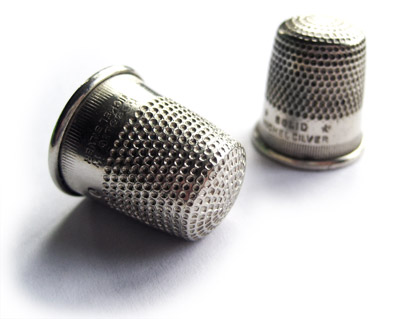 Well, you are if you collect thimbles.
Well, you are if you collect thimbles.
A thimble is the protective shield worn on the finger or thumb during sewing. At its most basic, it is a small cap worn over the fingertip to protect it when pushing a needle through cloth. Thimbles are still used in quilting, sewing, and other types of needlework.
The oldest thimbles in collections are suspected to be over 30,000 years old and made from—wait for it—bones! The earliest known Roman thimble dated to the first century AD was made of bronze and found at Pompeii.
The most common materials for making thimbles are metal, leather, rubber, wood, glass, or china. The earliest thimbles were made from whalebone, horn, or ivory. Thimble artists enhance their creations with semi-precious stones, by engraving ornate designs, and enameling. Early American thimbles featured miniature scrimshaw designs and are considered valuable collectibles. You can find these rare thimbles prominently displayed in a number of New England whaling museums.
Originating from Roman times, first-century thimbles were made from bronze. Bronze or clay were the favored materials of tenth- to fourteenth-century thimbles made in Europe and England. Thimbles from this era were embellished with decorations and are expensive and quite difficult to find.
England’s first thimble was made by a Dutch metal worker named Lofting in 1695. Lofting called it the “thumb-bell.” It was given this name quite obviously because it was shaped like a bell and worn on the thumb when in use. Over the years, the shape changed and the name was softened to ‟thimble.”
Thimbles made before the eighteenth century had small dimples on the outside that were made by hand punching. When a machine was invented to do the job, the shape and thickness of the metal changed. While early thimbles are quite thick and have a pronounced dome on top, the later ones are thinner and the top is flatter.
Silver became a popular material for nineteenth-century thimbles, but it was not practical because steel needles easily pierced it. The problem was solved by Charles Horner, who covered a steel core inside and out with silver. This more practical and durable thimble was still as pretty as the traditional silver one. Horne named his thimble the Dorcas, and they are very popular among digitabulists.